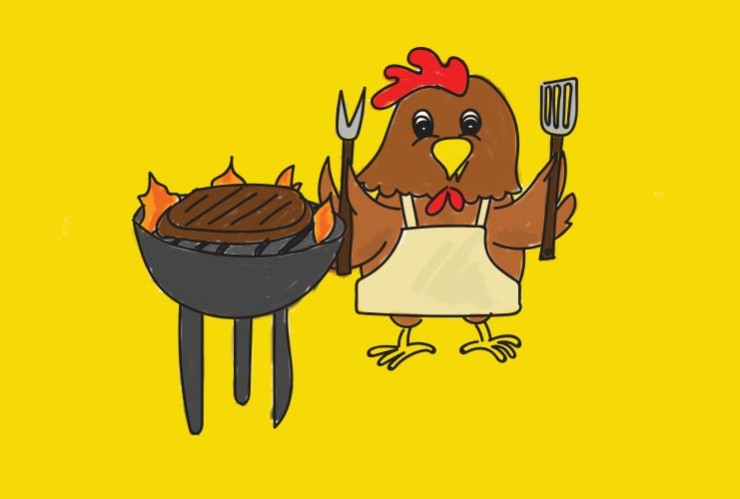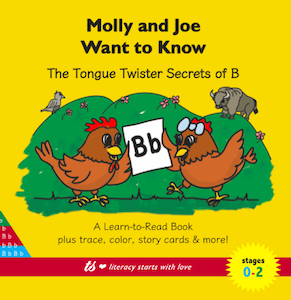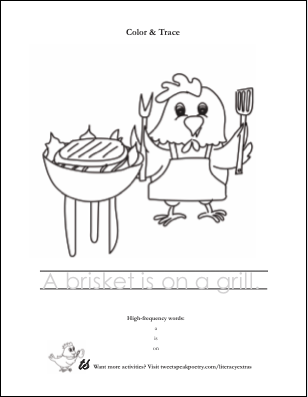Now, you can help a child learn to read with the young chickens Molly and Joe—two wide-eyed early readers who are full of curiosity, mischief, and mirth! Rich language and amusing illustrations combine with strategies that address how the brain remembers best: pattern, repetition, visual novelty, and multi-sensory experiences.
Children demonstrate six reading stages, from zero to five (print awareness to analysis and reasoning). Our first multi-level Molly and Joe Want to Know reader serves stages zero to two: print awareness, sound and letter pairing, and automatic reading.
You can use the Reader to read for pleasure (even for babies!); then teach the letter b; then teach or reinforce other sound/letter relationships, high-frequency words, new vocabulary, and writing.
In a move-quickly-from-one-thing-to-the-next culture, it can be surprising to learn that stage two learners benefit from repeated experience with the same texts and materials, until reading is automatic. To make the necessary repetition easy and fun, we’ve included simple games with cut-out materials (all reusable) and activities in the Reader. You’ll find Color & Trace Pages, Biscuit Bingo, Story Cards (for Matching, Story Train, Partners in Rhyme, and Story Challenge games), Letter Dress-Up Cards (for sound and letter associations and word building), and Sentence Builders.
Color and Trace “A brisket is on a grill”
So maybe you’re looking for extra, fun reading activities to support the learn-to-read journey. To that end, we’re sharing: “A brisket is on a grill.” (Joe is that delightful little chicken in an apron with a fork and spatula!) Our Color & Trace pages help teach high-frequency words, develop fine motor skills and handwriting, and solidify memory of the letter b or other sound/letter relationships. If you’ve already got the Molly and Joe reader, then you have other fun coloring pages that teach high-frequency words.
5 Fun Facts About Brisket
We’re thinking Molly and Joe probably enjoy something of a vegetarian lifestyle (and the occasional bug). But that doesn’t seem to stop Joe from grilling up a brisket for his omnivore friends. Here are 5 fun facts you may (or may not) know about brisket:
1. Brisket is one of the toughest cuts of meat. Maybe that’s why there’s a whole day dedicated to brisket, to help it feel better about itself. (May 28 is National Brisket Day in the U.S.)
2. Brisket is one of nine prime beef cuts. It’s taken from the area over the cow’s sternum. And because cows don’t have a collar bone like we humans do, it’s this area that bears most of the cow’s weight when it lies down.
3. In Mexican cuisine, you’ll see the brisket cut slow-cooked in a large circular pan, and the dish is called saudero.
4. Cows were not native to the American continents but were brought over by Spanish settlers.
5. “Burnt ends,” a staple of brisket-making, originated in the famous barbecue region of Kansas City. It used to be that the pitmaster would cut off the fattiest parts and toss them into stews or discard them as scraps. Now, they are resmoked into a “smoky, crunchy bark” craved by brisket lovers everywhere.
Watch a Video of How to Make Brisket Barbecue
Brisket Limerick Poetry Prompt
Try your hand at a brisket limerick. Use the “fun facts” as inspiration if you like. Need more inspiration? Check out our limerick infographic.
This book is so much fun! I used it with about 10 Kindergarten and first graders who are labeled as “at-risk,” (I like to call them my promising students), and we had a blast reading the poem and doing the activities. The poem produces giggles and conversation, and the activities are easy to prepare and fun to complete! Plus, I love that I can use the activities over again. This is a must have in a teacher’s classroom.
—Callie Feyen, at-risk literacy specialist
- Free E-Book + Poetry Prompt! - April 14, 2025
- Braving the Poem: Interview with Catherine Abbey Hodges - March 24, 2025
- National Poetry Month Is Here + Prompt! - March 14, 2025



Leave a Reply